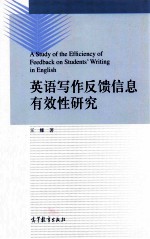
- 作 者:王娜
- 出 版 社:北京:高等教育出版社
- 出版年份:2014
- ISBN:9787040395860
- 标注页数:248 页
- PDF页数:264 页
请阅读订购服务说明与试读!
订购服务说明
1、本站所有的书默认都是PDF格式,该格式图书只能阅读和打印,不能再次编辑。
2、除分上下册或者多册的情况下,一般PDF页数一定要大于标注页数才建议下单购买。【本资源264 ≥248页】
图书下载及付费说明
1、所有的电子图书为PDF格式,支持电脑、手机、平板等各类电子设备阅读;可以任意拷贝文件到不同的阅读设备里进行阅读。
2、电子图书在提交订单后一般半小时内处理完成,最晚48小时内处理完成。(非工作日购买会延迟)
3、所有的电子图书都是原书直接扫描方式制作而成。
第一章 引言 1
1.1 Research background 5
1.2 Objectives of the research 9
1.3 Research questions 10
1.4 Significance of the research 11
1.5 An overview of chapters 13
第二章 国内外英语写作教师反馈信息研究综述 15
2.1 Introduction 16
2.2 Definitions of feedback 16
2.3 Multi-perspectives on feedback 17
2.4 Types offeedback in English writing learning 18
2.5 Roles of feedback in English writing learning 20
2.6 Multiple views on teacher written feedback 20
2.7 Previous studies of teacher written feedback 21
2.7.1 A framework for reviewing feedback studies 22
2.7.2 Feedback studies in L1 context 24
2.7.3 Feedback studies in L2/FL context 31
2.7.4 Feedback studies in the Chinese EFL writing learning context 37
2.8 Summary 39
第三章 理论框架 41
3.1 Introduction 43
3.2 Relevant theories 43
3.2.1 Social learning theories 43
3.2.1.1 Lave & Wenger's Community of Practice theory 44
3.2.1.2 Vygotsky's Zone of Proximal Development 45
3.2.2 SLA theories 45
3.2.2.1 Selinker's Interlanguage theory 46
3.2.2.2 Krashen's Input Hypothesis 47
3.2.2.3 Krashen's Interaction Hypothesis 48
3.3 A working model for the current research 49
3.4 Efficiency of feedback 52
3.5 Summary 56
第四章 研究设计与方法 57
4.1 Issues to be addressed 58
4.2 General introduction to the whole project 58
4.2.1 Preliminary study 61
4.2.2 Main study 63
4.3 Summary 64
第五章 前期研究 65
5.1 Methods & procedures 67
5.2 Data collection 68
5.2.1 Data source 68
5.2.2 Data types 69
5.3 Data analysis 70
5.3.1 Data sorting 70
5.3.1.1 Principles & procedures 70
5.3.1.2 Teacher feedback on students'writing 71
5.3.1.3 Errors in students'writing 85
5.3.2 Data analysis 89
5.3.2.1 Analytical analyses of teacher feedback 90
5.3.2.2 Error analysis 107
5.3.2.3 Stabilizations in Chinese EFL learners'writing 130
5.4 Summary 131
第六章 主要研究 135
6.1 Research hypotheses 137
6.2 Methods & procedures 138
6.3 Subjects 139
6.4 Settings 140
6.5 Data collection 143
6.5.1 Students'texts 144
6.5.2 Electronic feedback 146
6.5.3 Students'revisions 151
6.5.4 A questionnaire survey 152
6.5.5 Students'responses to feedback 154
6.5.6 The writing instructor's evaluation of feedback 155
6.6 Data analysis 155
6.6.1 Analyzing the quality of students'texts 155
6.6.1.1 Analyzing structural organization 156
6.6.1.2 Analyzing range ofvocabulary 157
6.6.2 Analyzing students'revisions 157
6.6.3 Analyzing questionnaire data 157
6.6.4 Analyzing students'responses to feedback 158
6.6.5 Analyzing the writing instructor's evaluation of feedback 158
6.7 Summary 158
第七章 研究结果与分析 159
7.1 Introduction 161
7.2 Impacts of the e-feedback 161
7.2.1 Impacts on students'general writing ability 162
7.2.1.1 Analysis ofstructural organization 162
7.2.1.2 Analysis of diversity of vocabulary 163
7.2.2 Impacts on students'writing performance 165
7.2.3 Analysis of students'revisions 166
7.2.4 Students'responses to feedback 171
7.2.4.1 Students'attitudinal evaluation of feedback 172
7.2.4.2 Students'performance evaluation of feedback 184
7.2.5 The instructor's evaluation of feedback 187
7.2.6 Summary 187
7.3 New types of teacher&student relationships 188
7.3.1 New teacher identity & roles 189
7.3.2 New student identity & roles 190
7.4 A suggested model for Chinese EFL writing teachers 191
7.4.1 Focuses of feedback 194
7.4.2 Forms of feedback 195
7.4.3 Functions of feedback 196
7.5 Summary 197
第八章 结论与启示 199
8.1 Summary of major findings 202
8.2 Research products 206
8.2.1 A corpus of teacher feedback 206
8.2.2 E-feedback to stabilizations in Chinese EFL learners'writing 207
8.3 Limitations of the current research 208
8.4 Implications for Chinese EFL writing instructions 209
8.5 Conclusion 212
Bibliography 215
Acknowledgements 233
Appendix A:Examples of E-feedback 234
Appendix B:Questionnaires 238
Appendix C:Students'Responses to Feedback 245
